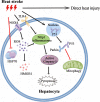The pathogenesis and therapeutic strategies of heat stroke-induced liver injury
- PMID: 36528615
- PMCID: PMC9758799
- DOI: 10.1186/s13054-022-04273-w
The pathogenesis and therapeutic strategies of heat stroke-induced liver injury
Abstract
Heat stroke (HS) is a life-threatening systemic disease characterized by an elevated core body temperature of more than 40 ℃ and subsequent multiple organ dysfunction syndrome. With the growing frequency of global heatwaves, the incidence rate of HS has increased significantly, which has caused a huge burden on people's lives and health. Liver injury is a well-documented complication of HS and usually constitutes the direct cause of patient death. In recent years, a lot of research has been carried out on the pathogenesis and treatment strategies of HS-induced liver injury. In this review, we summarized the important pathogenesis of HS-induced liver injury that has been confirmed so far. In addition to the comprehensive effect of systemic factors such as heat cytotoxicity, coagulopathy, and systemic inflammatory response syndrome, excessive hepatocyte cell pyroptosis, dysfunction of Kupffer cells, abnormal expression of heat shock protein expression, and other factors are also involved in the pathogenesis of HS-induced liver injury. Furthermore, we have also established the current therapeutic strategies for HS-induced liver injury. Our study is of great significance in promoting the understanding of the pathogenesis and treatment of HS-induced liver injury.
Keywords: Heat stroke; Liver injury; Pathogenesis; Therapeutic strategy.
© 2022. The Author(s).
Conflict of interest statement
The authors declare no competing financial interests.
Figures


References
-
- Tsai HY, Hsu YJ, Lu CY, Tsai MC, Hung WC, Chen PC, et al. Pharmacological activation of aldehyde dehydrogenase 2 protects against heatstroke-induced acute lung injury by modulating oxidative stress and endothelial dysfunction. Front Immunol. 2021;12:740562. doi: 10.3389/fimmu.2021.740562. - DOI - PMC - PubMed
Publication types
MeSH terms
Grants and funding
LinkOut - more resources
Full Text Sources
Medical

